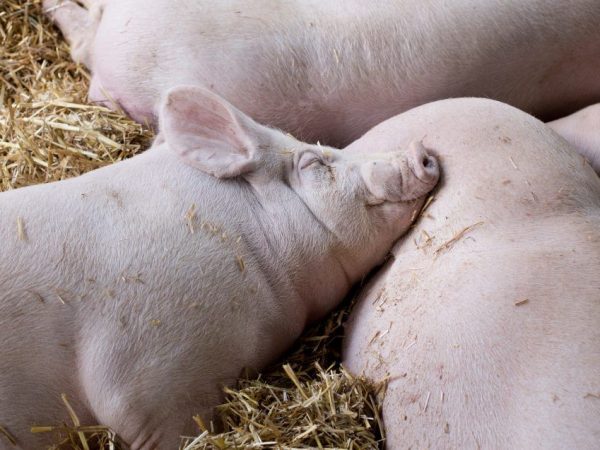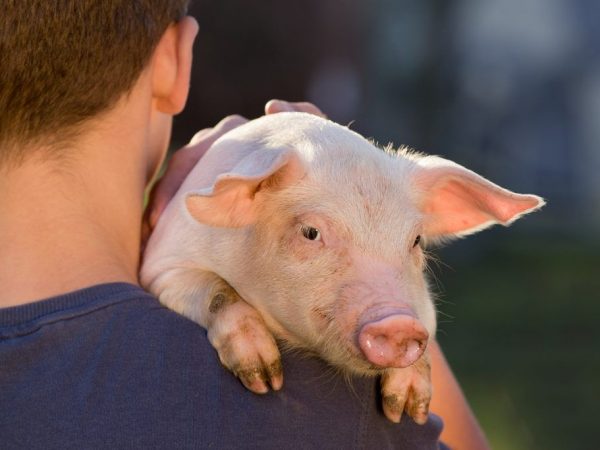Characteristics of pigs of breed Large White
At the moment, the Large White breed of pigs is in demand all over the world. This species is quite common because of its excellent adaptability to harsh living conditions, both climatic and forage.

Description of a pig breed Large White
In the 19th century, an especially large and hardy breed of pigs was bred in Foggy Albion, and by the end of the century there was a threat of degeneration of Yorkshire pigs. That is why all professional farms united and created some special characteristics of Large White pigs and agreed that they would not cross this species with other breeds for the sake of preserving the purity of the blood. This is how the pure Large White breed appeared.
Spread
In our countries, the Large White Pig appeared in the last century (in the 80s). About 80% of the livestock accounts for these representatives. More good species have been bred thanks to the active participation of this subspecies of farm artiodactyls.
The breed of White Large pigs has changed quite a lot during breeding in our territories in comparison with the English animals that were originally. The new selection is distinguished by a fairly strong constitution, excellent fertility and adaptation to life in regions with special conditions, in any climate.
Appearance
Large White breed of pigs primarily refers to the fat-meat direction. The head of its representatives is light, the constitution is harmonious and balanced, the mouth and snout are small, regular in shape, the patch is slightly concave from the profile. The ears are elastic, wide, small in thickness, but large in size. The body is long, a wide dorsal region, the chest region and loin are large, well-developed musculature. The back is arched, the spine is very strong. The legs of such a pig are short and without large folds, with hooves of the correct shape.
Farmers or owners of small private farms will hardly be able to distinguish a purebred white pig from a Ukrainian lard-meat or from an Estonian one, because outwardly they can find a lot in common. Of the differences, the large weight and height of the English pig is noted. Its body reaches a length of 2 m.
Pros and cons of breeding
The described breed is often called the optimal choice in order to cross them in order to create species with excellent properties. In addition, the advantages include:
- excellent fertility;
- rapid entry into the age of slaughter and reproduction;
- weight gain, obstinacy in food.
English animals show a stable propensity for obesity if the diet contains a large amount of grains. They also do not like severe frosts, but at the same time, productivity will fall even with strong rays of the sun.
How to make the right choice
Any farmer can easily purchase the White Pig livestock on the ordinary agricultural market as well as on private farms.To begin with, you should pay attention to strong piglets. An absolutely healthy animal will run away with a squeal at the outstretched hand.
Also, a normal pig is distinguished by a constant desire to eat something, mobility, activity and good sound data. It is worth knowing that by its 2 months, the white breed of pigs must show a weight of at least 20 kg. Thanks to the facts described above, it is easy to tell a healthy piglet from a weak one. Such a baby weighs a little, does not react in any way to touch.

Breeding pigs of breed Large White
When buying a large number of pigs, you need to be vigilant, because sometimes sellers can deliberately slip a few frail ones into a batch. In no case should you take the time to review each pig. Before buying, be sure to ask what feed the pigs have eaten since birth, what vitamins they took, what probiotics were given, how often they ate.
You need to get answers to each of these questions, because if you drastically change the pig's daily lifestyle, it will refuse food, as a result of which it will lose weight and, possibly, growth.
Correct keeping of a large pig
The large White Pig is quite thermophilic and does not tolerate any sudden cold snaps. Before settling this species in a pigsty, it must be insulated. The ideal option would be a concrete screed, insulated with foam, because then the animals will not be able to damage anything and there will be no sudden changes in temperature. Straw, sawdust or a wooden platform will keep the pigs cool even in the coldest weather. The top of the shed is usually insulated with fresh straw, placed either under the roof or on the floor of the attic.
With stable, even slight hypothermia, pigs can get pneumonia, which most often ends in the death of animals. This must be taken seriously and be able to identify the first symptoms of the disease: lost activity, lethargy and lack of appetite, increased tearing, rapid breathing, wheezing or coughing, increased body temperature.

Caring for large pigs
Any of the above symptoms is worth the attention of the breeder, especially when it comes to small pigs. If for individuals older than six months, the last stage of inflammation is fatal, then babies may die early.
A good outcome of any disease entirely depends on the skillful help of a specialist. If it is problematic to call a veterinarian at home, then you need to try to neutralize the fever in the pig yourself. To do this, it will be enough to use drugs from a home veterinary first-aid kit or ordinary paracetamol with an analgesic effect, which will perfectly relieve fever and calm the animal. But here it is worth watching the dosage, because taking more than 1 g at a time (with a weight of 40 kg) can be harmful. Tablets should be crushed and added to water, not food, because a sick animal often has no appetite.
You should not limit yourself to pre-medical help, the sick individual must be shown to the doctor.
Food
Animals of this type more than others need good proteins and amino acids. As the piglets get older, they need quality feed, because grain alone is not enough to get tasty meat. A regular grain diet affects weight gain, but not meat. On grain or regular feed, the pig will get fat and gain a greasy layer. Special grass flour, silage mass, herbs, plants should be added to the feed. Vitamins are also indispensable.
Growing rules
Piglet care begins from the first minutes of life, the primary task is pruning and proper processing of its umbilical cord. The body of each baby must be wiped with a soft cloth or clean burlap. For farrowing alone, the uterus gives an average of fifteen piglets, in the first birth their number, of course, is less, but the number is growing every time.
After the offspring are born, they need to be warmed up, and this must be done even before the sow starts giving birth. The optimum temperature for newborn piglets is 28 ° C. If it is cool in the pigsty, babies, due to the lack of natural immunity to hypothermia, can get pneumonia and simply die in 3 days.
In addition, the help of the owner will be needed during the first feeding - the newly born offspring. The owner will have to hold the babies by the muzzles, correctly applying them to the nipples of the sow. This must be done in the first 45 minutes after birth, because then the piglet's vitality will increase, the sucking baby will ease the pain during labor for the mother.
When the piglet finishes eating colostrum, it needs to be weaned from the sow, placing it in a separate enclosure for housing. Such pigs rarely go for a walk and most of the time they just eat, gaining weight.
The breed gives a healthy, strong and numerous offspring, which grows rapidly and gains a large mass. Starting from the third day, babies can be given complementary foods, supplementing the mother's milk, and released for walks. The diet of the sow after the survey should not be changed, because this can adversely affect the level of milk abundance and its taste.
Conclusion
Many breeders are impressed by the characteristics of the large white pig breed, because it is financially profitable, it is easy to maintain and breed, piglets of the White Large breed demonstrate a high survival rate. If you follow all the above tips and treat the livestock well, the offspring will be excellent and the animals will gain weight correctly.

